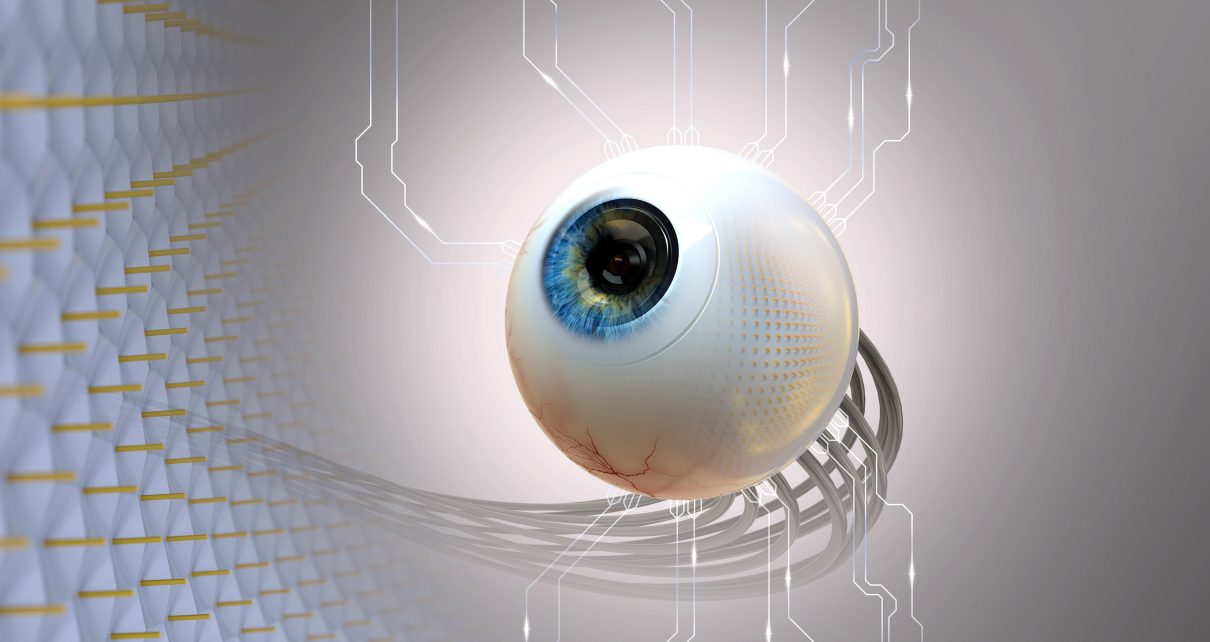The human eye is a sophisticated instrument: images enter through a curved lens at the front of the sphere and pass through its gooey, vitreous liquid before reaching the light-sensitive retina—which relays the signal to the optic nerve that carries the picture to the brain. Engineers have attempted to replicate this structure for about a decade. Now a new artificial eye successfully mimics the natural instrument’s spherical shape. Researchers hope this achievement could lead to sharper robotic vision and prosthetic devices. A paper on the development was published on Wednesday in Nature.
The research built on the fact that perovskite, a conductive and light-sensitive material used in solar cells, can be used to create extremely thin nanowires several thousandths of a millimeter in length. These wires mimic the structure of the eye’s long, thin photoreceptor cells, says study co-author Zhiyong Fan, an electronic and computer engineer at the Hong Kong University of Science and Technology. “But the difficulty is: How can we fabricate an array of the nanowires in a hemispherical substrate to form this hemispherical retina?” he adds. Constructing a curved retina is important because light only hits it after passing through a curved lens. “When you try to image something, the image that forms after the lens is actually curved,” says Hongrui Jiang, an electrical engineer at the University of Wisconsin–Madison, who reviewed the new paper but was not directly involved in the work. “If you have a flat sensor, then the image cannot be focused very sharply.” The retina is curved, but electronic light sensors are rigid and flat.
To solve the problem, Fan and his colleagues deformed soft aluminum foil into a hemispherical shape. Then they treated the metal with an electrochemical process that converted it into an insulator called aluminum oxide. This process also left the material studded with nanoscale pores. As a result, the researchers were left with a curved hemisphere that had convenient densely clustered holes in which they could “grow” perovskite nanowires. “The density of the nanowires is very high,” Jiang says. “It’s comparable—it’s actually even higher—than the density of the photoreceptors in human eyes.”
Once they had their curved “retina,” the scientists incorporated it into an artificial eye that included a curved lens at the front. Inspired by the specialized liquid in a real eye, the team filled its biomimetic version with an ionic liquid, a type of liquid salt in which charged particles can move. “One very important component inside is in the cavity we filled [with] ionic liquids,” Fan says. “Once these nanowires generate charges, the charge will be exchanged with some ions.” This electrical exchange allows the perovskite nanowires to perform the electrochemical function of detecting light and sending that signal to external image-processing electronics.
When the team tested the artificial eye, it managed to process patterns of light in as little as 19 milliseconds—half the time required by a human eye. And it produced images that had a greater contrast and clearer edges than those generated by a flat image sensor with a similar number of pixels. In some ways, the artificial eye improved on natural vision: it could pick up a greater range of wavelengths and lacked a blind spot.
Fan hopes to work with medical researchers to build prosthetic devices based on his team’s design. Doing so could require much more development, however. The artificial eye is “really elegant; it looks like amazing work,” says Jessy Dorn, vice president of clinical and scientific affairs at biomedical company Second Sight, who was not involved in the research. “But [the study authors] don’t talk about how it could possibly be connected to the human visual system.” She works on blindness-treating devices, including a retinal prosthesis called the Argus II, and points out that developing the electronic interface is only the first step. Such a device will need to interact with the human brain to produce images. “That’s one of the bigger challenges: how to get any kind of high-resolution interface safely and reliably implanted and then [to] work with the human visual system.”
Furthermore, there are different types of blindness, and perfect eyes may not always produce perfect vision. For example, brain development during infancy and childhood is crucial to processing visual input—so a person who is born blind may never have the brain wiring required to see through prosthetic eyes later in life. Dorn notes that recipients of the Argus II implant are all adults who lost their vision much later. And even they have different levels of success: some only gain the ability to differentiate light and shadow, while others can process shapes. Still, she says that any visual connection to the environment can result in more independence and greater freedom of movement. And prostheses are not the only valuable application of artificial eyes: such devices could have immediate applications in robotic vision.
“Mimicking the natural eyes has been a dream for many optical engineers,” Jiang says, noting that some researchers seek to imitate mammalian eyes and that others work with insectlike compound ones. The field is finally beginning to have real breakthroughs, he adds. “I think in about 10 years, we should see some very tangible practical applications of these bionic eyes.”




